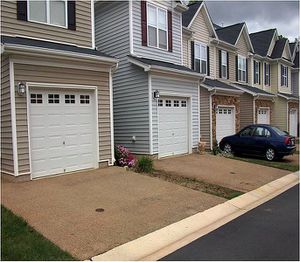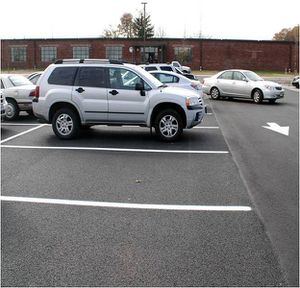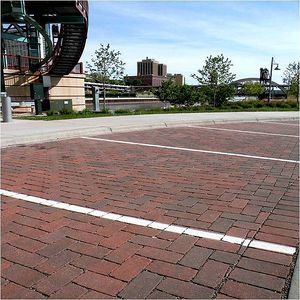
The most commonly used permeable pavement surfaces are pervious concrete, porous asphalt and permeable interlocking pavers. Examples of these three variants of permeable pavement are illustrated in Photos 1, 2 and 3. Pervious concrete is a special type of concrete with a high porosity used for concrete flatwork applications that allows water from precipitation and other sources to pass directly through, thereby reducing the runoff from a site and allowing groundwater recharge. The high porosity is attained by a highly interconnected void content. Typically pervious concrete has little or no fine aggregate and has just enough cementitious paste to coat the coarse aggregate particles while preserving the interconnectivity of the voids. Pervious concrete is traditionally used in parking areas, areas with light traffic, residential streets, pedestrian walkways, and greenhouses. Porous asphalt is standard hot-mix asphalt with reduced sand or fines and allows water to drain through it. Porous asphalt over an aggregate storage bed will reduce stormwater runoff volume, rate, and pollutants. The reduced fines leave stable air pockets in the asphalt. The interconnected void space allows stormwater to flow through the asphalt as shown in Figure 1, and enter a crushed stone aggregate bedding layer and base that supports the asphalt while providing storage and runoff treatment. When properly constructed, porous asphalt is a durable and cost competitive alternative to conventional asphalt.
Permeable interlocking concrete pavement (PICP) consists of concrete (or stone) paver units with open, permeable spaces between the units. They give an architectural appearance, and can bear both light and heavy traffic, particularly interlocking concrete pavers, excepting high-volume or high-speed roads. Some products are polymer-coated and entirely porous face. Other variants not discussed in the articles on permeable pavement include single-sized aggregate, porous turf, permeable clay brick pavements, resin bound paving, and bound recycled glass porous pavement.
To assist with selection of the type of surface, a general comparison of the properties of the three major permeable pavement types is provided in Table 1. Designers should check with product vendors and the local review authority to determine specific requirements and capabilities of each system. Schematic cross sections of each system are illustrated in the design section for permeable pavement.
Table 1:
Summary of properties of permeable pavements.
Link to this table
| Properties | Pervious concrete | Porous asphalt | PICP |
|---|---|---|---|
| Typical pavement surface thicknessa | 5 to 8 inches | 3 to 4 inches (thicker for high wheel load applications) | 3 inchesa |
| Bedding layera,f | None | 1 in. AASHTO No. 57 stone | 2 inches of AASHTO No. 8 stone (MnDOT 3127 FA-3) |
| Reservoir layerb,f | AASHTO No. 57 stone or per hydraulic design | AASHTO No. 2, 3, or 5 stone | 4 inches of AASHTO No. 57 stone over No. 2, 3 or 4 stone |
| Construction properties |
|
|
|
| Installed surfacing costc | 3 to $4/square foot | $2/square foot | 3 to $4/square foot |
| Minimum batch size | |||
| Longevityd | |||
| Overflow | |||
| Runoff temperature reduction | |||
| Surface colors/texture | Range of light colors and textures | Black or dark grey colors | Wide range of colors, textures and patterns |
| Load bearing capacitye | |||
| Surface cleaningg | Periodic vacuuming; replace jointing stones if completely clogged and uncleanable | ||
| Other issues |
|
|
Avoid winter sanding |
| Design references | [1] | [2] | [3] |
aThickness may vary depending on site and traffic conditions
bReservoir storage may be augmented by corrugated metal pipes, plastic arch pipe or plastic lattice crates
cSupply and install minimum surface thickness only; minimum 30,000 sf with Minnesota 2012 prevailing labor wages. Does not include base reservoir, drainage appurtenances, engineering, or inspection
dBased on pavement being properly maintained. Resurfacing or rehabilitation may be needed after the indicated period
eDepends primarily on on-site geotechnical considerations and structural design computations
f ASTM D448 Standard Classification for Sizes of Aggregate for Road and Bridge Construction or ASASHTO M-43
gPeriodic vacuuming frequency determined from inspection, intensity of use, and other potential sediment sources


